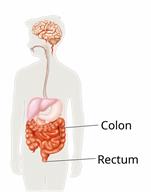Hirschsprung Disease

Hirschsprung disease is a rare condition that affects the large intestine (colon). It makes it hard for the colon to move poop (stool) out of the body like it should. This can cause constipation.
Hirschsprung disease is often diagnosed at birth or soon after. It needs to be treated with surgery. It can cause a serious infection called enterocolitis, even after surgery.
What are the causes?
The cause of this condition is not known. It may run in families or be passed from parent to child (inherited).
Children who have Hirschsprung disease may also be born with other conditions. These may be part of a syndrome, such as Down syndrome.
What increases the risk?
Your child is more likely to develop Hirschsprung disease if:
What are the signs or symptoms?
Signs and symptoms in infants may include:
Not pooping within 2 days after birth. This is one of the most common signs.
Green or brown vomit.
Diarrhea. In some cases, there may be blood in the diarrhea.
Distension. This is when the abdomen swells.
In mild cases, the disease may not be found until later in childhood. Signs and symptoms in older children may include:
How is this diagnosed?
Hirschsprung disease is diagnosed based on your child's symptoms, a physical exam, and tests. Tests may include:
An X-ray of the abdomen or colon. Dye may be injected in the colon (barium enema).
A biopsy. This is when a small piece of tissue is removed from the colon for testing.
Anal manometry. This measures the pressure in the rectum. A balloon is inserted and inflated in the rectum.
This condition cannot be diagnosed before birth.
How is this treated?
Hirschsprung disease is treated with a surgery called a pull-through procedure. During this procedure, the part of the colon that does not work is removed. Then, the healthy end is pulled through and attached to the rectum.
The procedure may be done in stages. If your child is too weak or sick to have the full procedure, an ostomy can be done. An ostomy is when:
The part of the colon that does not work is removed. The healthy end is attached to an opening (stoma) in the abdomen. In some cases, the whole colon has to be removed.
Poop will come through the stoma and collect in a pouch.
When your child is ready, the opening may be closed. Then the pull-through procedure can be done.
In some cases, the ostomy is permanent, and the pull-through procedure is not done.
Your child may also need:
Antibiotics, if they get an infection.
Fluids given through an IV.
A tube that goes through their nose and down into their stomach (nasogastric tube, or NG tube).
Nutrition. This may be given through an IV.
Follow these instructions at home:
Medicines
-
Give over-the-counter and prescription medicines only as told by your child's health care provider.
-
If your child was prescribed antibiotics, give them as told by your child's provider. Do not stop giving the antibiotic even if your child starts to feel better.
General instructions
Contact a health care provider if:
-
The surgical site is red or warm.
-
The surgical site has drainage that is bloody or smells bad.
-
Your child vomits or is constipated.
-
Your child has bloating in their abdomen.
-
Your child shows signs of dehydration.
-
The skin around the ostomy becomes broken down.
-
The poop from the ostomy is bloody.
- Your child has signs of enterocolitis. These may include:
Diarrhea that smells bad or has blood in it.
Diarrhea with explosive poop or gas.
A fever.
Pain and a tender or swollen abdomen.
A lack of energy.
Vomiting.
This information is not intended to replace advice given to you by your health care provider. Make sure you discuss any questions you have with your health care provider.
